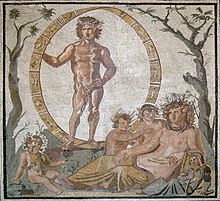
Back أيون (إله) Arabic إيوس ARZ আইয়ন (দেবতা) Bengali/Bangla Aion Breton Aion (mitologija) BS Eó (mitologia) Catalan Aion Esperanto Eón (mitología) Spanish Aioon Estonian آیون (ایزد) Persian

Aion (from Hellenistic Greek: αἰών, romanized: aión, lit. 'long period of time', [ai̯ˈɔːn]) is a Hellenistic deity associated with time, the orb or circle encompassing the universe, and the zodiac. The "time" which Aion represents is perpetual, unbounded, ritual, and cyclic: The future is a returning version of the past, later called aevum (see Vedic Sanskrit Ṛtú). This kind of time contrasts with empirical, linear, progressive, and historical time that Chronos represented, which divides into past, present, and future.[2]: 274
Aion is thus a god of the cyclic ages, and the cycle of the year and the zodiac. In the latter part of the Classical era he became associated with mystery religions concerned with the afterlife, such as the mysteries of Cybele, the Dionysian mysteries, Orphic religion, and the Mithraic mysteries. In Latin, the concept of the deity may appear as Aeternitas, Anna Perenna, or Saeculum.[2]: 274 He is typically in the company of an earth or mother goddess such as Tellus or Cybele, as on the Parabiago plate.[2]: 274